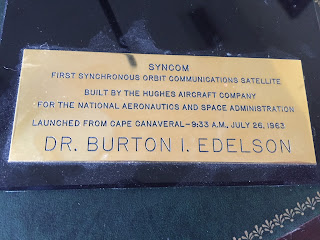If you follow the arrow, you arrive at this phone which sadly, is not currently connected to anything:
 |
| "New" Phone in our Office |
I'm so pleased by this arrangement that I've just made a quick inventory of our vintage telephonic equipment.
I have this classic candlestick phone which is pictured sitting on top of my victrola (actually, it's in my house, not in the office, but I think that still counts are part of the RetroEdTech collection):
 |
| Classic Candlestick Phone |
There's this odd Scandinavian phone which weighs about a ton and which I use to have connected to the phone system. It's an old dial rotary phone with a very visible pair of bells. Over a decade ago, someone in my house clipped its wires (don't ask, it's an xwife story...).
I have this nice 1960's dial rotary phones made for ATT by its subsidiary Western Electric. It has that nice mid Century modern look.
And lastly, and it's a bit of a non sequitur, here is a model of the first geosynchronous communications satellite to be placed in orbit. What it has in common with the telephones is that it was part of the telecom communications revolution and its in my collection. The plaque on the base says:
"SYNCOM
The first synchronous orbit communications satellite.
Built by the Hughes Aircraft Company
for the National Aeronautics and Space Administration.
Launched from Cape Canaveral, 9:33 am, July 26, 1963."
 |
| Syncom 1963 |
The reason that I have and treasure such a thing is that Burton Edelson was my dad so I grew up on dinner time conversation about the march of technology and how it was changing communications and the world. We regularly discussed geosynchronous orbit at dinner. I'm embarrassed to say that I don't remember the exact altitude at which this is a stable orbit.
 |
| Syncom Model Plaque for Burton Edelson |



1 comment:
A geostationary equatorial orbit (GEO) is a circular geosynchronous orbit in the plane of the Earth's equator with a radius of approximately 42,164 km (26,199 mi) (measured from the center of the Earth). A satellite in such an orbit is at an altitude of approximately 35,786 km (22,236 mi) above mean sea level.
Post a Comment